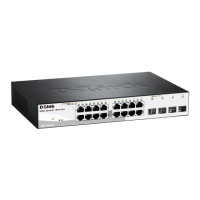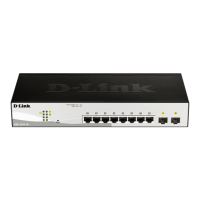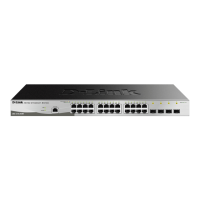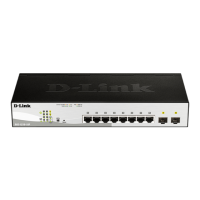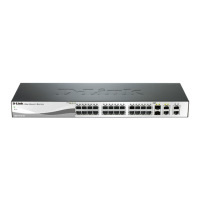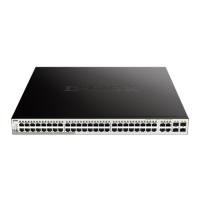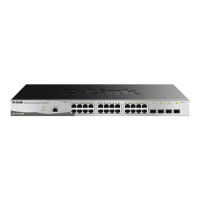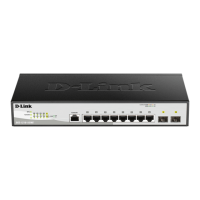Do you have a question about the D-Link DGS-1216T and is the answer not in the manual?
Explains the objective of the guide.
Defines key terms used in the manual.
Details the features and benefits of Gigabit Ethernet technology.
Explains the importance and evolution of Fast Ethernet technology.
Describes the approach to improving Ethernet limits via switching.
Explains VLANs and their utilities like security and cost reduction.
Lists the key features and capabilities of the DGS-1216T switch.
Guides on opening the package and verifying contents.
Provides guidelines for installing the switch in a suitable environment.
Details rack mounting and surface installation procedures.
Explains network cable and AC power connections.
Describes the front panel of the switch and its components.
Details the 16 Gigabit Ethernet ports and their capabilities.
Describes the two mini-GBIC ports and their optional module support.
Details the rear panel components, including power connector and reset button.
Explains the Power and CPU (System) LED indicators.
Details LEDs for Ports 1-16, including Link/Activity and speed.
Explains LEDs for the mini-GBIC ports.
Provides step-by-step instructions for installing the switch management utility.
Explains how to discover, monitor devices, and view traps.
Covers configuring device parameters like IP address, subnet mask, and system name.
Details firmware updates and accessing the switch via web browser.
Describes the functions available in the Web Management Utility toolbar.
Guides the user through the login process for the switch management interface.
Allows configuration of port speed, duplex mode, and flow control.
Covers VLAN configuration and trunking for increased bandwidth.
Details port mirroring and Quality of Service (QoS) configuration.
Explains Spanning Tree Protocol (STP) and SNMP configuration.
Covers Jumbo Frame settings and viewing the device status.
Details statistics reporting and system configuration options.
Covers trap settings, password changes, backup, and reset operations.
Describes how to exit the web configuration interface.
Lists general standards, protocols, and port details.
Details physical dimensions, power, temperature, and humidity requirements.
Outlines performance aspects like transmit method, address table, and packet rates.
Explains the objective of the guide.
Defines key terms used in the manual.
Details the features and benefits of Gigabit Ethernet technology.
Explains the importance and evolution of Fast Ethernet technology.
Describes the approach to improving Ethernet limits via switching.
Explains VLANs and their utilities like security and cost reduction.
Lists the key features and capabilities of the DGS-1216T switch.
Guides on opening the package and verifying contents.
Provides guidelines for installing the switch in a suitable environment.
Details rack mounting and surface installation procedures.
Explains network cable and AC power connections.
Describes the front panel of the switch and its components.
Details the 16 Gigabit Ethernet ports and their capabilities.
Describes the two mini-GBIC ports and their optional module support.
Details the rear panel components, including power connector and reset button.
Explains the Power and CPU (System) LED indicators.
Details LEDs for Ports 1-16, including Link/Activity and speed.
Explains LEDs for the mini-GBIC ports.
Provides step-by-step instructions for installing the switch management utility.
Explains how to discover, monitor devices, and view traps.
Covers configuring device parameters like IP address, subnet mask, and system name.
Details firmware updates and accessing the switch via web browser.
Describes the functions available in the Web Management Utility toolbar.
Guides the user through the login process for the switch management interface.
Allows configuration of port speed, duplex mode, and flow control.
Covers VLAN configuration and trunking for increased bandwidth.
Details port mirroring and Quality of Service (QoS) configuration.
Explains Spanning Tree Protocol (STP) and SNMP configuration.
Covers Jumbo Frame settings and viewing the device status.
Details statistics reporting and system configuration options.
Covers trap settings, password changes, backup, and reset operations.
Describes how to exit the web configuration interface.
Lists general standards, protocols, and port details.
Details physical dimensions, power, temperature, and humidity requirements.
Outlines performance aspects like transmit method, address table, and packet rates.
| Switching Capacity | 32 Gbps |
|---|---|
| Forwarding Rate | 23.8 Mpps |
| MAC Address Table | 8K |
| Dimensions | 440 x 180 x 44 mm |
| Jumbo Frame Support | Yes |
| Switch Type | Unmanaged |
| Packet Buffer Memory | 512 KB |
| Jumbo Frame Size | 9KB |
| Operating Temperature | 0°C to 40°C |
| Storage Temperature | -10°C to 70°C |
| Humidity | 10% to 90% (non-condensing) |
| Ports | 16 x 10/100/1000Mbps |

